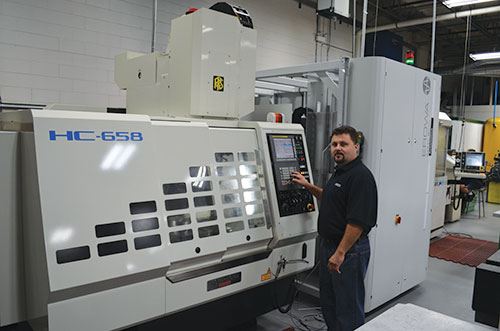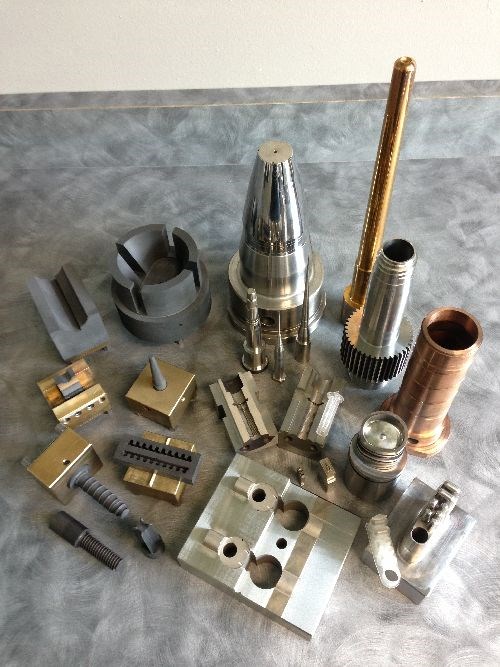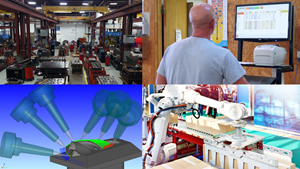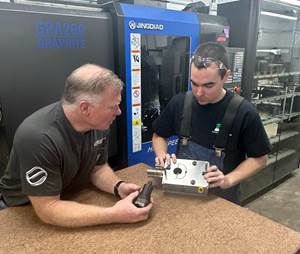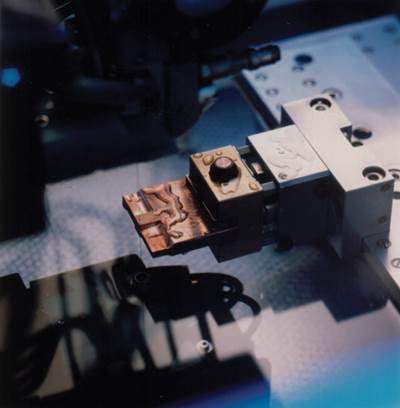“Fixing” to Get More Accurate, Increase Productivity with Automation
The Roku-Roku machine, EROWA workholding system and the EROWA Robot Multi form the production team. Optimally used, this team can deliver up to four times higher productivity.
Hommer Tool & Mfg.—a custom mold-ready components manufacturer based in Arlington Heights, IL—was looking to increase its productivity without adding manpower or sacrificing accuracy. The company began looking at automation as a way to achieve these goals. After now implementing automation into its process, the company can run electrodes and workpieces unattended, which has increased productivity substantially.
Established in 1983, Hommer’s components are geared toward plastic injection molds and die casting tools for industries such as medical, dental, pharmaceutical, consumer product packaging, and industrial and automotive die casting. The company prides itself on producing tight tolerance work. Hommer’s Production Manager, John Passaro, notes that this is not easily attained. “It takes very skilled workers and constant inspection throughout the entire process to make sure each part—from the first to the last—is identical and ready for our customers production, regardless of quantity,” he emphasizes “We can have roughly 250 jobs in process at any given time to manage, schedule and make sure they run throughout every process as smoothly as possible while maintaining our customer’s specs. We are not a ‘fit and function’ shop that can make our own decisions on any deviations to print. We are supplied specs and have to duplicate the component exactly.”
Stringent requirements such as the ones outlined above had the company looking at methods to produce its components in the quickest yet most accurate manner possible. Passaro notes that much of the work Hommer does requires .0005 to as little as .0001 total tolerances. “We are able to accomplish this in our finish grinding, hard turning, hard milling, honing, EDM and wire EDM departments,” he states. “The finishes we attain are based on our customer’s needs but range from 16 to 30 EDM VDI finishes, 6 to 8 RMS ground finishes, 8 to 12 RMS hard turn and hard mill finishes.”
A Fix on Fixturing
Hommer recently purchased a Roku-Roku HC-658 high speed mill (HSM). The company immediately realized it was able to maintain the same .0002 tolerances expected from its jig grinding and ID grinding processes with the new HSM. “Based on the type of work we do—which is 90 percent round workpieces in 32 to 64 piece lot sizes, we had to come up with an efficient way of fixturing our parts that currently was not available from any manufacturer. This would allow us to run multiple work pieces and maintain the accuracies required,” Passaro says. “Our team developed a design—we manufactured a few prototypes to test and came up with a successful fixture.”
Passaro elaborates on that process. “We manufactured a multi-V fixture that could hold six workpieces. We ended up altering the design a few times to improve it, overall it took about six months to develop our final design.” The final result is that Hommer has 15 fixtures that can hold a total of 90 parts. They are in the process of producing a new multi-V fixture to hold four pieces at a time for larger diameter stock. “The six-position multi-V fixture can hold as small as .062”-1.150” diameter x 10-inch long parts; and our new four-position multi-V can hold from .500”-1.875” diameter x 12-inch long part,” he states. “We also wanted to be able to run our electrodes unattended somehow, as we can have as many as 180 going through production at a time.”
After Hommer grasped the potential it could realize with fixturing, the company sought a way to automate this process. Passaro called two automation manufacturers to see what options were available. He discovered Arlington Heights, IL-based EROWA Technology, Inc.’s Robot Multi, which has the capacity for 180 electrodes and 30 workpiece/fixture pallets was the best fit. “We were already using EROWA pallets for locating our fixtures,” Passaro notes. “No other offering had the self-contained layout we required without adding multiple racks and/or magazines.”
The EROWA Robot Multi’s clearly arranged magazine holds up to 270 pallets and can switch automatically to the associated pallet type on the same CNC machine. In the gripper dock, various grippers required for the automatic change are stored in a space-saving arrangement. “The Roku-Roku machine, EROWA workholding system and the EROWA Robot Multi form the production team,” notes EROWA Technology, Inc.’s COO Chris Norman. “Optimally used, this team can deliver up to four times higher productivity.”
“We were very surprised at the ease of implementation,” Passaro continues. “EROWA was very helpful and were in and out in a few days without any issues at all.” Training of two Hommer employees only took a few hours, and Passaro notes downtime was minimal. The company was able to machine as the install took place. “One other valuable offering from EROWA is that their tech support is available 24 hours a day/seven days a week and is very helpful over the phone,” he adds. “We initially had some issues with our guys not remembering some of the controls—but we were able to be back up and running within an hour.”
Increased Capacity/Decreased Leadtimes
Passaro notes that the programming is very easy. The user simply calls up the pallet number he wants loaded and calls up the G-code program to run the part. “We actually had a 40-hour run on the second day after install of 60 electrodes,” he says. “We are using EROWA’s 50 mm holders for our electrodes—which is a no brainer for automated runs; and we mounted 6 x 6 Hermann Schmidt HSM magnets and our custom multi-V fixtures for the workpieces on EROWA’s 148 mm pallets. We can’t fixture all of our jobs based on Ø and length of the parts we make, so if we can’t fixture them in our multi-V’s or on the 6 x 6 magnets then we have the option to machine one piece at a time without the robot.”
Hommer is extremely satisfied with the addition of the EROWA Robot Multi. “Having this automated cell gives us great results and has increased our capacity—which consequently decreased our leadtimes,” Passaro states. “We were in dire need of a new carbon cutting mill, but adding this robot has eliminated that need. We are able to cut both steel and carbon in one machine—without sacrificing money or time. We also would have never been able to have unattended runs by adding another mill. Our EDM sinker department now has electrodes well in advance of the job—due to the unattended robot runs—directly resulting in increased productivity.”
Related Content
Tool Paths, ERP & Improving Efficiency in Your Toolroom: What Did You Miss in February?
We covered a variety of topics in February. From tool paths to ERP and PTXPO coverage, we hope you didn’t miss anything but here is your cheat sheet if you did.
Read MoreMMT Chats: Eliminating the Noise to Stay Focused on the Customer
Metro Mold & Design joins me to discuss the value of the 80/20 rule as a business strategy, its talented cross-functional team, the role of automation in mold building and molding, and the continuing impact of COVID-19.
Read MoreFive-Axis Graphite Mill With Automation Debottlenecks Electrode Machining
Five-axis electrode cutting enabled Preferred Tool to EDM complex internal screw geometry on an insert that otherwise would have had to be outsourced.
Read MoreQuality Tool & Die Enhances Performance With Advanced EDM and Milling Technologies
The adoption of Mitsubishi wire and sinker EDMs, along with the OPS Ingersoll five-axis milling machine with automated cells, has enabled unmanned operations and improved precision. As a result, QTD has expanded its facility, grown its workforce and increased its business by 10-15% annually.
Read MoreRead Next
How to Produce Consistent, Repeatable Electrodes
When it comes to electrode production, workholding and automation technology must be accurate and consistent to ensure repeatability and reduce machining time.
Read MoreAre You a Moldmaker Considering 3D Printing? Consider the 3D Printing Workshop at NPE2024
Presentations will cover 3D printing for mold tooling, material innovation, product development, bridge production and full-scale, high-volume additive manufacturing.
Read MoreHow to Use Continuing Education to Remain Competitive in Moldmaking
Continued training helps moldmakers make tooling decisions and properly use the latest cutting tool to efficiently machine high-quality molds.
Read More
